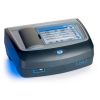Hach COD in Salt/Seawater TNTplus Vial Tests
For photometric determination of low range COD by the reactor digestion method.
Features
- Easy and safe handling
- No reagent blank necessary
- Automatic method detection
- Expedited repair and warranty service
- Lifetime technical support
- More
For saline COD samples with Chloride concentrations up to 20,000 mg/L Cl-1 COD
For photometric determination of low range COD by the reactor digestion method.
High Chloride concentrations usually interfere COD testing and lead to a high bias. Samples with low COD cannot simply be diluted since the COD detection limit is crucial.
TNT815 is a safe, reliable and very easy to use method for the photometric detection of low range COD in saltwater samples, e.g. in seawater.
The Direct Read Technology will provide your COD result to the nearest mg/L! No more cleaning glassware and dealing with large amounts of hazardous reagents and waste.
- Digestion Required: Yes
- Instrument: DR3900, DR6000, DR1900
- Method: 10299
- Method Name: Reactor Digestion
- Number of tests: 25
- Parameter:COD (for samples up to 20000 mg/L Chloride)
- Platform: TNT plus™
- Range: 7 - 70 mg/L COD
- Shelf Life: 12 months from production date
- Storage Conditions: 15 - 25 °C (protect from light)
In The News
Wildfire Prevention in the Sierra Nevada Region with the Yuba Watershed Institute
Though recent wildfires have sparked new conversations about wildfire management and response, groups like the Yuba Watershed Institute have been monitoring the forests and water resources of the Sierra Nevada region for decades, managing approximately 5,000 acres of land with the Bureau of Land Management (BLM) and about 7,000 acres in private land partnerships. The goal of the Institute is to work with local communities and land agencies to improve watershed and forestry management through informed practices and public outreach. The goals of the Yuba Watershed Institute are three-fold: Improve the ability of fire suppression agencies like the California Department of Forestry and Fire Protection ( CAL FIRE ) and the US Forest Service.
Read MoreWave Sensors Integration with NexSens Buoys: A Cutting-Edge Solution for Wave Measurment
Real-time wave data supports accurate weather prediction, safe and efficient maritime operations, and provides valuable safety and operating condition information for recreation and commercial fishing. Understanding wave dynamics also helps with the design of protective coastal structures like seawalls, breakwaters, and jetties. It also supports better prediction of their impact on sediment transport and coastal geomorphology. Wave data is a key factor in qualifying and designing offshore wind farms and harnessing kinetic energy for electrical generation. It helps with the understanding of ocean-atmosphere interactions and contributes to studies of sea-level rise and climate change impacts.
Read MoreSpring 2025 Environmental Monitor Available Now
In the Spring 2025 edition of the Environmental Monitor, we highlight partnerships across the world and the importance of collaboration between government agencies, universities, environmental groups, local communities, and other stakeholders. From great white shark research in Cape Cod to monitoring fisheries in Lake Erie, this latest edition underscores partnerships that connect stakeholders in a watershed through environmental data. With an emphasis on data sharing, a combination of real-time and discrete sampling keeps the public and partners informed of environmental conditions. Our writers also sought out science professionals dedicated to working with peers within and outside of the environmental sector.
Read More








